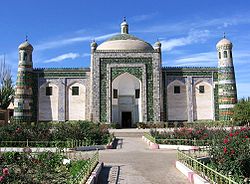
Afaq Khoja Mausoleum
Encyclopedia

Muslim
A Muslim, also spelled Moslem, is an adherent of Islam, a monotheistic, Abrahamic religion based on the Quran, which Muslims consider the verbatim word of God as revealed to prophet Muhammad. "Muslim" is the Arabic term for "submitter" .Muslims believe that God is one and incomparable...
site in Xinjiang
Xinjiang
Xinjiang is an autonomous region of the People's Republic of China. It is the largest Chinese administrative division and spans over 1.6 million km2...
. It is located
some 5 km north-east from the centre of Kashgar
Kashgar
Kashgar or Kashi is an oasis city with approximately 350,000 residents in the western part of the Xinjiang Uyghur Autonomous Region of the People's Republic of China. Kashgar is the administrative centre of Kashgar Prefecture which has an area of 162,000 km² and a population of approximately...
City, in Haohan Village , which has also been known as Yaghdu.
History
The mausoleum was initially built ca. 1640 as the tomb of Muhammad Yūsuf, a Central Asian NaqshbandiNaqshbandi
Naqshbandi is one of the major Sufi spiritual orders of Sufi Islam. It is considered to be a "Potent" order.The Naqshbandi order is over 1,300 years old, and is active today...
Sufi master who had come to the Altishahr region (today's southern Xinjiang
Xinjiang
Xinjiang is an autonomous region of the People's Republic of China. It is the largest Chinese administrative division and spans over 1.6 million km2...
) in the early 17th century, and possibly was also active in spreading Sufism
Sufism
Sufism or ' is defined by its adherents as the inner, mystical dimension of Islam. A practitioner of this tradition is generally known as a '...
in China proper
China proper
China proper or Eighteen Provinces was a term used by Western writers on the Qing Dynasty to express a distinction between the core and frontier regions of China. There is no fixed extent for China proper, as many administrative, cultural, and linguistic shifts have occurred in Chinese history...
.
Later, Muhammad Yūsuf's more famous son and successor, Afāq Khoja, was buried there as well. All told, the beautiful tiled mausoleum contains the tombs of five generation
Generation
Generation , also known as procreation in biological sciences, is the act of producing offspring....
s of the Afāqi family, providing resting places for 72 of its members.
The monument is also known as Xiangfei's tomb, as it is the burial place of one of Afaq Khoja's descendants, Iparhan, said to be the legendary "fragrant concubine", Xiangfei, who was the wife of a rogue leader who was captured by the Qianlong emperor and taken to Beijing
Beijing
Beijing , also known as Peking , is the capital of the People's Republic of China and one of the most populous cities in the world, with a population of 19,612,368 as of 2010. The city is the country's political, cultural, and educational center, and home to the headquarters for most of China's...
to be his imperial concubine. Refusing to serve him, a Ugyhur tale said she was forced to commit suicide or was murdered by the Emperor's mother.
Description
The Mausoleum is perhaps the finest example of Islamic architectureIslamic architecture
Islamic architecture encompasses a wide range of both secular and religious styles from the foundation of Islam to the present day, influencing the design and construction of buildings and structures in Islamic culture....
in Xinjiang. A large dome of 56 ft (17 m) is at the center surrounded by four corner minarets with stripes and arabesque
Arabesque
The arabesque is a form of artistic decoration consisting of "surface decorations based on rhythmic linear patterns of scrolling and interlacing foliage, tendrils" or plain lines, often combined with other elements...
floral patterns. Each of the windows of the minarets are in a different geometric pattern while the tops have turrets with an inverted lotus dome and scalloped edges. The entrance to the mausoleum is a majestic facade and a tiled iwan-niche
Niche (architecture)
A niche in classical architecture is an exedra or an apse that has been reduced in size, retaining the half-dome heading usual for an apse. Nero's Domus Aurea was the first semi-private dwelling that possessed rooms that were given richly varied floor plans, shaped with niches and exedras;...
style typical of Central Asian mosques.
The tombs are decorated with blue glazed tiles and draped in colorful silks. Inside the tomb hall is the Casket of Ikparhan which supposedly carried her from Beijing.
There is a mausoleum, four prayer halls which are supported by wooden beams with muqarnas on the capitals, a lecture hall and a cemetery which is still in use by the Ugyhur population and has distinctive mud and brick tombs. A gateway also has blue glazed tiles and there is a pond in the courtyard for people to cleanse before entering.

